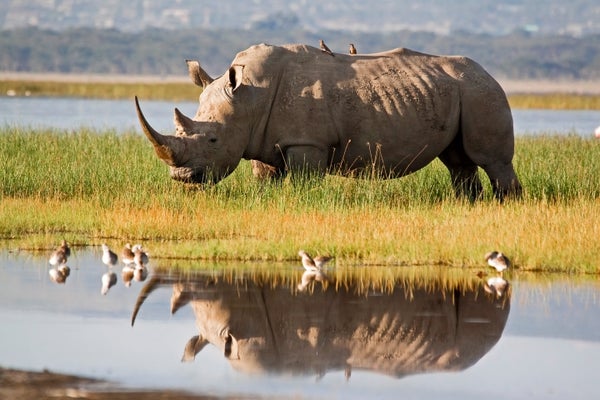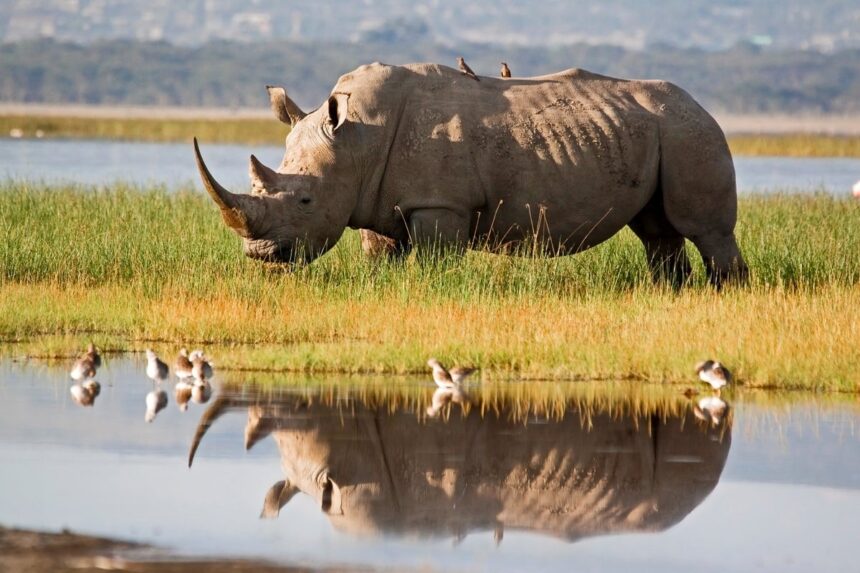Ancient Tooth Proteins Rewrite the Rhino Family Tree—Are Dinosaurs Next?
Molecules from the 20-million-year-old teeth of a rhino relative are among the oldest ever sequenced, opening tantalizing possibilities to scientists

Rhinos’ evolutionary relationships became a little clearer with the sequencing of the oldest proteins yet.
Researchers have described proteins that they say are among the most ancient ever sequenced. Two teams, which analysed molecules from extinct relatives of rhinos and other large mammals, have pushed back the genetic fossil record to more than 20 million years ago.
The studies — out in Nature today — suggest that proteins survive better than researchers thought. This raises the possibility of gleaning molecular insights about evolutionary relationships, biological sex and diet from even older animals — maybe even dinosaurs.
“You’re just opening up a whole new set of questions that palaeontologists never thought they could get near,” says Matthew Collins, a palaeoproteomics specialist at the University of Cambridge, UK, and the University of Copenhagen.
On supporting science journalism
If you’re enjoying this article, consider supporting our award-winning journalism by subscribing. By purchasing a subscription you are helping to ensure the future of impactful stories about the discoveries and ideas shaping our world today.
Preserved in teeth
The ability to obtain DNA from remains that are thousands of years old has revolutionized biology, revealing previously unknown human groups such as the Denisovans and rewriting the population history of humans and other animals. The oldest sequenced DNA comes from one-million-year-old mammoth bones and two-million-year-old Arctic sediments.
Proteins — biological building blocks encoded by the genome — are hardier than DNA and can push researchers’ abilities to use molecules to understand ancient species deeper into the past. How far is contentious. In 2007 and 2009, researchers described shards of protein from 68-million-year-old and 80-million-year-old dinosaur fossils, respectively, but many scientists doubt the claims.
A 2017 effort to redo the 2009 work was more convincing, says Enrico Cappellini, a biochemist at the University of Copenhagen. Yet it obtained only a limited number of sequences — the list of amino acids that describes a protein’s composition — providing only tentative information about evolutionary relationships, he says. He and his colleagues consider the current benchmark for the oldest evolutionarily informative protein ever discovered to be collagen extracted from a 3.5-million-year-old relative of camels from the Canadian arctic.
To push this limit further, in one of the two latest studies, Cappellini’s team extracted proteins from the enamel — the mineralized outer layer of teeth — of a 23-million-year-old relative of rhinoceroses. The fossil was found on an island in Canada’s High Arctic region in 1986 and stored in an Ottawa museum. A 2024 preprint attributed it to a new, extinct rhino species called Epiaceratherium itjilik.
Using mass spectrometry — which detects the weight of a protein fragment, allowing its composition to be inferred — the researchers identified partial sequences from 7 enamel proteins, making up at least 251 amino acids in total.
An evolutionary tree integrating these sequences with genome data from living rhinos and of their two Ice Age relatives revealed a surprise. The Epiaceratherium sample belonged to a branch of the rhino family tree that split off earlier than any other: between 41 million and 25 million years ago. Previous studies placed this group among modern rhinos. “It really does change the way we have to think about the evolution of rhinos,” says Ryan Paterson, a biomolecular palaeontologist at the University of Copenhagen, who co-led the study.
Next step, dinosaurs
Proteins degrade in the heat. The rhino sample that Paterson and his colleagues analysed came from a polar desert where average temperatures are well below freezing, “the perfect place” for protein preservation, he says.
The Turkana Basin in Kenya could be considered one of the worst — and yet it is the source of fossils as old as 18 million years, from which a second team sequenced enamel proteins. Ground surface temperatures there can reach 70 °C, and climate records suggest Turkana Basin has been “one of the hottest places in the world for a very long time,” says Daniel Green, an isotope geochemist at Harvard University in Cambridge, Massachusetts, who co-led the study.
The Kenyan enamel-protein sequences — from extinct relatives of rhinos, elephants, hippos and other creatures — fit with classifications made by palaeontologists on the basis of the fossils’ bone anatomy. But Green hopes that future studies of ancient proteins from Turkana will be able to solve some evolutionary mysteries, such as the origins of hippos. He and his colleagues also hope that ancient proteins can be obtained from early hominin remains found in Turkana Basin.
“Being able to show that we can get back to 18 million years in this kind of really hot, harsh environment, really shows that the world is open for working on palaeoproteomics,” says Timothy Cleland, a physical scientist at the Smithsonian Museum Science Conservation Institute in Suitland, Maryland, who co-led the Turkana study. He’s especially interested in trying to get proteins out of the teeth of dinosaurs, but that will be a challenge, because their enamel is especially thin, he says.
The studies are a major technical achievement, says Deng Tao, a palaeontologist at the Institute of Vertebrate Paleontology and Paleoanthropology in Beijing. But as researchers look even further back in time for ancient proteins, he hopes the results will be able to support meaningful insights into the history of life, “rather than just a competitive pursuit of the oldest records”.
Although the studies focus on evolutionary relationships, Collins is more excited about the prospects of gathering other insights from ancient proteins, including data on biological sex — based on the potential presence of types of enamel protein that are found only in animals with Y chromosomes — and information about where an animal sits in the food chain, written in nitrogen isotopes in amino acids, he says. “What can you do with it? Everything. It’s like, wow!”
This article is reproduced with permission and was first published on July 9, 2025.








